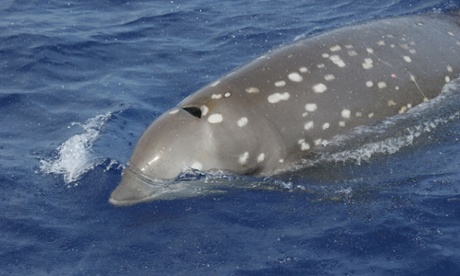Beaked whale sets new mammalian dive record
When it comes to marine mammals, Cuvier’s beaked whale is the new champion of deep-sea diving

The southern elephant seal is famous for its diving talents, for many years recognised as the marine mammal with the deepest and longest dive on record. But researchers in the US have identified a new champ: Cuvier’s beaked whale.
Cuvier’s beaked whale was always a contender, but its diving habits are so extreme it has proved a difficult species to study. Thanks to some clever satellite-linked tags, however, marine biologists have been able to collect data that reveal its diving behaviour in unprecedented detail. One of the whales they tracked went on a monster dive to a depth of almost 3km. Another individual performed a dive that saw it holding its breath for an incredible 137.5 minutes. These are both “new mammalian dive records,” report Gregory Schorr and colleagues in a paper just out inPLOS ONE.
The researchers managed to attach dive recorders on or near the dorsal fin of eight beaked whales and follow their movements off the coast of southern California. Previous research has suggested that Cuvier’s beaked whale has two diving modes: long, deep foraging expeditions that characterised by echolocation; and shorter, shallower, silent dives whose purpose remains something of a mystery. The data presented by Schorr et al. confirm this picture, with deep dives typically reaching more than 1400m and lasting for over an hour.
Up until this revelation, the southern elephant seal had been leading the marine mammal field for both depth and duration of dive. A studypublished in 2010 recorded an elephant seal diving to 2388 m. Anotherpaper from way back in 1992 timed one seal staying submerged for 120 minutes. In the field of pinniped diving, the elephant seal is still the boss. But at the higher taxonomic scale of marine mammals, the beaked whale is now top of the class.
There is much to marvel at here. I’m impressed by the whales, of course. The fact of these incredible dives just makes the world a more interesting place in which to live. I also like the sound of the “Mk10-A Argos-linked dive recorders”, the bit of kit that made this study possible.
But this paper is interesting for another reason. Cuvier’s beaked whale accounts for some 69% of recorded marine mammal strandings associated with military sonar operations. “Without a doubt, a valuable application of this data set would be a detailed assessment of whale behavior in the presence and absence of acoustic disturbance,” the authors write.
Although detailed records of sonar use “are much less readily available than one might expect,” Schorr and his colleagues are working to identify incidents of sonar use that occurred during the data collection. If they can do this, it will be interesting to see whether these had any obvious effect upon the extraordinary diving behaviour of this remarkable species







0 comments:
Post a Comment